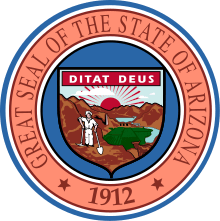Thomas Edward Campbell
| Thomas Edward Campbell | |
|---|---|
 | |
| 2nd Governor of Arizona | |
|
In office January 1, 1917 – December 25, 1917 January 6, 1919 – January 1, 1923 | |
| Preceded by | George W. P. Hunt (1917 & 1919) |
| Succeeded by | George W. P. Hunt (1917 & 1923) |
| Personal details | |
| Born |
January 18, 1878 Prescott, Arizona Territory |
| Died |
March 1, 1944 (aged 66) Phoenix, Arizona |
| Political party | Republican |
Thomas Edward Campbell (January 18, 1878 – March 1, 1944)[1] was the second governor of the state of Arizona,[2] United States. He is the first Republican and first native-born governor elected after Arizona achieved statehood in 1912.
In 1917, he was initially declared the governor of Arizona in a disputed gubernatorial election but the decision was later overturned by the courts, who awarded the election to George W.P. Hunt. Campbell ran for governor again and won two terms. He died in 1944. He played instrumental roles in the drafting of Arizona's tax and revenue laws and adoption of the Colorado River Compact that allocated water rights among the western states.[3]
Early years
Born in 1878 in Prescott, Arizona, to Daniel and Eliza (Flynn) Campbell, who came to Fort Whipple in 1873 where Daniel worked until 1887. Campbell was the first graduate of Prescott High School in 1893 and went on to St. Mary's College of California in Oakland where he studied geology, but did not receive a degree. In 1894, he became assistant postmaster of Jerome and after service in the Spanish–American War then returned to Prescott where he became postmaster of the nearby town of Jerome in 1899. The following year he married Gayle Allen whose father was an agent of the United Verde Copper Company.
In 1900, Campbell was elected to the Arizona Territorial Legislature introducing a bill mandating an eight-hour workday. Campbell was appointed Yavapai County Tax Assessor in 1907 and held that post until 1914 when he was elected Arizona State Tax Commissioner.[1][4]
Governor
During the 1916 election held on November 7, Campbell ran against incumbent George W.P. Hunt who was seeking election to his third term. Initially, Campbell was declared the winner by 30 votes but Hunt refused to vacate the governor's office and both men took the oath of office on December 30, 1916.
Hunt filed suit in the Arizona Superior Court on January 25, 1917, and on January 27, the court declared Campbell de facto governor. Hunt agreed to turn over the office on January 29, but appealed and on December 22, 1917, the Arizona Supreme Court overturned the lower court ruling. Campell vacated the office on December 25, but also filed an appeal with the Arizona Supreme Court on January 8, 1917, that was denied.[5]
One of the most significant events during Campbell's year in office was the Bisbee Deportation in which "deputies" kidnapped approximately 1,300 striking mine workers, their supporters from the Industrial Workers of the World (IWW), and other residents of the town of Bisbee. The workers were loaded onto trains and taken approximately 200 mi (320 km) into New Mexico and abandoned without money or access to transportation and warned not to return to Bisbee. The "deputies" were recriuted by the Phelps Dodge Corporation which owned the Bisbee mine and ruled Bisbee with an iron hand after the deportations.
Campbell later admitted that he was embarrassed by the excessive actions by the striking workers and the mine company response. He visited Bisbee after the incident and condemned both the IWW and deportation.[1]
Also during his 1917 tenure, the flag of Arizona was adopted by the legislature without Campbell's consent. Campbell never explained his reasons for not signing the bill.[6]
Later life
Campbell was reelected to the governor's office in November 1918 and again in 1920 but lost again to Hunt in 1922. Campbell went on to become a member of the Republican National Committee and served as president of the United States Civil Service Commission from 1930 to 1933. He died March 1, 1944, of a cerebral hemorrhage while on the grounds of the state capitol in Phoenix and is buried in Prescott.[1][3]
References
- 1 2 3 4 "Thomas E. Campbell". University of Arizona: The Bisbee Deportation of 1915. 2005. Retrieved 2011-02-09.
- ↑ "Arizona's Governors". State of Arizona. 2011. Retrieved 2011-02-09.
- 1 2 "Governor Thomas E. Campbell". jeff.scott.tripod.com. February 9, 2011. Retrieved 2011-02-09.
- ↑ "Thomas Campbell Collection Finding Aid" (PDF). Sharlot Hall Museum. Retrieved 2011-02-09.
- ↑ "Arizona State History". shgresources.com. 2011. Retrieved 2011-02-09.
- ↑ "The Arizona State Flag". Arizona State Library, Archives and Public Records Division, Arizona Secretary of State. January 13, 2010. Retrieved 2011-02-09.
| Political offices | ||
|---|---|---|
| Preceded by George W.P. Hunt |
Governor of Arizona 1917 (Prior to court resolving disputed election) |
Succeeded by George W.P. Hunt |
| Preceded by George W. P. Hunt |
Governor of Arizona 1919–1923 |
Succeeded by George W.P. Hunt |
